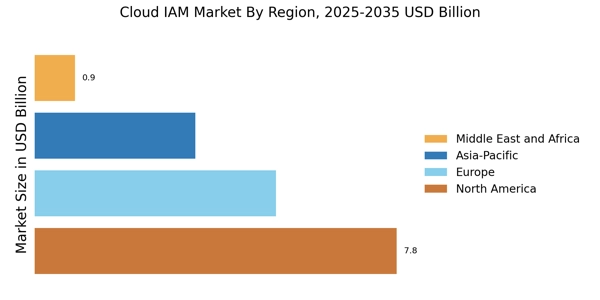The Cloud Identity and Access Management (IAM) market is currently characterized by intense competition and rapid innovation, driven by the increasing demand for secure digital environments. Key players such as Microsoft (US), Amazon (US), and Google (US) are at the forefront, leveraging their extensive cloud infrastructures to enhance IAM solutions. Microsoft (US) focuses on integrating AI capabilities into its Azure Active Directory, aiming to streamline user experiences while bolstering security. Amazon (US), through its AWS platform, emphasizes scalability and flexibility, catering to a diverse clientele with varying security needs. Google (US) continues to innovate with its BeyondCorp initiative, promoting a zero-trust security model that aligns with modern enterprise requirements. Collectively, these strategies not only enhance their market positions but also shape a competitive landscape that prioritizes security, user experience, and adaptability.
In terms of business tactics, companies are increasingly localizing their services to meet regional compliance requirements, which appears to be a critical factor in their operational strategies. The Cloud IAM Market is moderately fragmented, with a mix of established players and emerging startups. This fragmentation allows for a diverse range of solutions, yet the influence of major players remains substantial, as they set industry standards and drive technological advancements.
In August 2025, Microsoft (US) announced a significant partnership with a leading cybersecurity firm to enhance its Azure Active Directory's threat detection capabilities. This collaboration is poised to strengthen Microsoft's position in the market by integrating advanced threat intelligence into its IAM solutions, thereby addressing the growing concerns around cyber threats. Such strategic alliances are indicative of a broader trend where companies seek to bolster their offerings through partnerships, enhancing their competitive edge.
In September 2025, Amazon (US) unveiled a new feature within its IAM services that utilizes machine learning to automate user access reviews. This innovation not only streamlines administrative tasks but also enhances security by ensuring that access rights are continuously monitored and adjusted based on user behavior. The introduction of such features reflects Amazon's commitment to leveraging technology to improve operational efficiency and security, which is likely to resonate well with its enterprise customers.
In July 2025, Google (US) expanded its IAM capabilities by integrating advanced analytics into its Cloud Identity platform. This move aims to provide organizations with deeper insights into user behavior and access patterns, facilitating more informed decision-making regarding security policies. By enhancing its analytics capabilities, Google positions itself as a leader in providing data-driven IAM solutions, which could attract organizations looking for comprehensive security strategies.
As of October 2025, the competitive trends in the Cloud IAM Market are increasingly defined by digital transformation, AI integration, and a focus on sustainability. Strategic alliances are becoming more prevalent, as companies recognize the value of collaboration in enhancing their service offerings. Looking ahead, competitive differentiation is likely to evolve from traditional price-based competition to a focus on innovation, technological advancements, and the reliability of supply chains. This shift underscores the importance of not only meeting customer needs but also anticipating future demands in a rapidly changing digital landscape.


















Leave a Comment